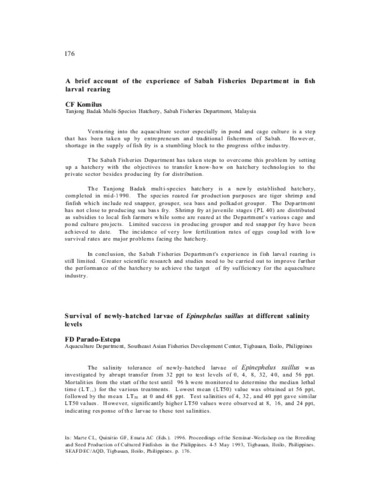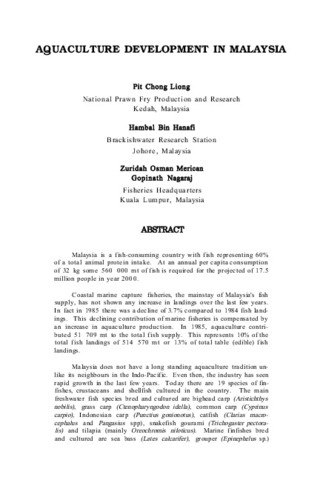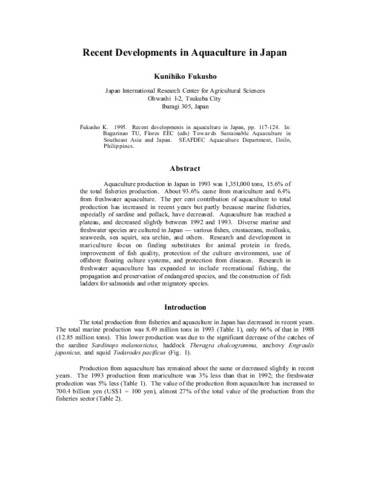A brief account of the experience of Sabah Fisheries Department in fish larval rearing
- Global styles
- MLA
- Vancouver
- Elsevier - Harvard
- APA
- Help

Date
1996Page views
7,969ASFA keyword
AGROVOC keyword
Taxonomic term
Metadata
Show full item record
Share
Abstract
Venturing into the aquaculture sector especially in pond and cage culture is a step that has been taken up by entrepreneurs and traditional fishermen of Sabah. However, shortage in the supply of fish fry is a stumbling block to the progress of the industry.
The Sabah Fisheries Department has taken steps to overcome this problem by setting up a hatchery with the objectives to transfer know-how on hatchery technologies to the private sector besides producing fry for distribution.
The Tanjong Badak multi-species hatchery is a newly established hatchery, completed in mid-1990. The species reared for production purposes are tiger shrimp and finfish which include red snapper, grouper, sea bass and polkadot grouper. The Department has not close to producing sea bass fry. Shrimp fry at juvenile stages (PL 40) are distributed as subsidies to local fish farmers while some are reared at the Department's various cage and pond culture projects. Limited success in producing grouper and red snapper fry have been achieved to date. The incidence of very low fertilization rates of eggs coupled with low survival rates are major problems facing the hatchery.
In conclusion, the Sabah Fisheries Department's experience in fish larval rearing is still limited. Greater scientific research and studies need to be carried out to improve further the performance of the hatchery to achieve the target of fry sufficiency for the aquaculture industry.
Suggested Citation
Komilus, C. F., & Parado-Estepa, F. D. (1996). A brief account of the experience of Sabah Fisheries Department in fish larval rearing. In C. L. Marte, G. F. Quinitio, & A. C. Emata (Eds.), Proceedings of the Seminar-Workshop on Breeding and Seed Production of Cultured Finfishes in the Philippines, Tigbauan, Iloilo, Philippines, 4-5 May 1993 (p. 176). Tigbauan, Iloilo, Philippines: Aquaculture Department, Southeast Asian Fisheries Development Center.
Type
Conference paperISBN
9718511326
Related items
Showing items related by title, author, creator and subject.
-
Aquaculture development in Thailand
Sirikul, Boonsong; Luanprida, Somsak; Chaiyakam, Kanit; Sriprasert, Revadee (Aquaculture Department, Southeast Asian Fisheries Development Center, 1988)Aquaculture practised in Thailand is in the form of pond culture and cage culture in freshwater, brackishwater and coastal areas. The main species cultured include freshwater prawns, brackishwater shrimp, cockles, mussels, ... -
Aquaculture development in Malaysia
Liong, Pit Chong.; Hanafi, Hambal Bin.; Merican, Zuridah Osman.; Nagaraj, Gopinath. (Aquaculture Department, Southeast Asian Fisheries Development Center, 1988)Malaysia is a fish-consuming country with fish representing 60% of a total animal protein intake. At an annual per capita consumption of 32 kg some 560 000 mt of fish is required for the projected of 17.5 million people ... -
Recent developments in aquaculture in Japan
Fukusho, K. (Aquaculture Department, Southeast Asian Fisheries Development Center, 1995)Aquaculture production in Japan in 1993 was 1,351,000 tons, 15.6% of the total fisheries production. About 93.6% came from mariculture and 6.4% from freshwater aquaculture. The per cent contribution of aquaculture to total ...






